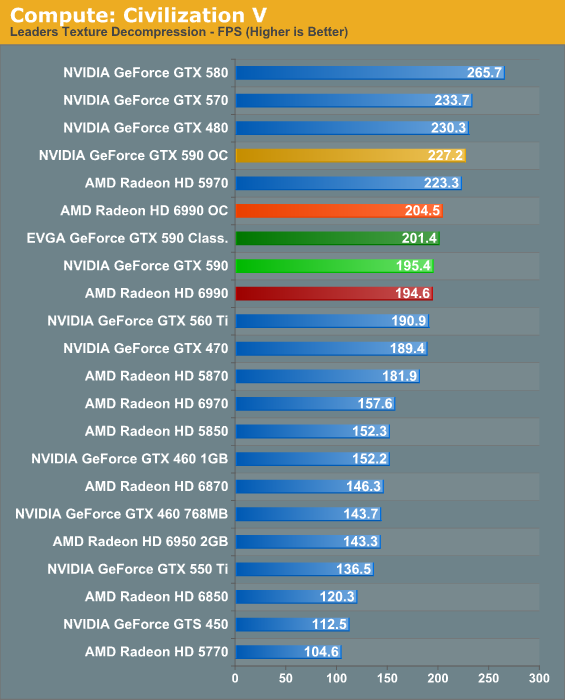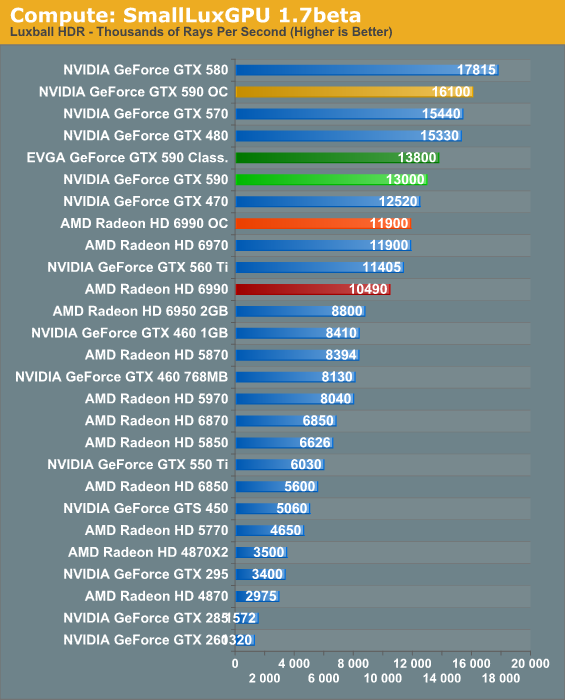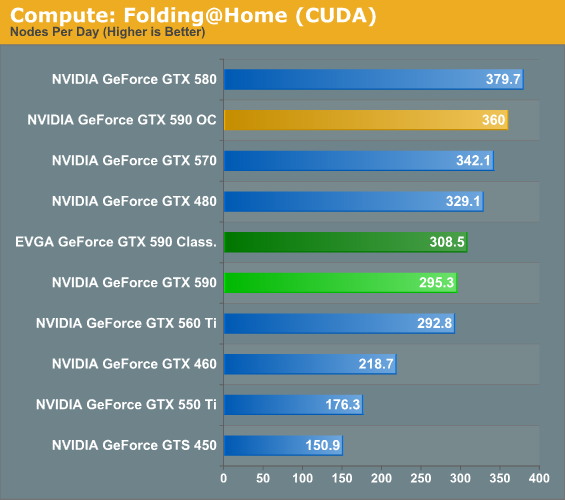NVIDIA’s GeForce GTX 590: Duking It Out For The Single Card King
by Ryan Smith on March 24, 2011 9:00 AM ESTCompute
Moving on from our look at gaming performance, we have our customary look at compute performance.
Our first compute benchmark comes from Civilization V, which uses DirectCompute to decompress textures on the fly. Civ5 includes a sub-benchmark that exclusively tests the speed of their texture decompression algorithm by repeatedly decompressing the textures required for one of the game’s leader scenes.

In the game world Civ5 benefits significantly from SLI and CrossFire. For our texture compression test however AFR is more a liability than a benefit. This doesn’t impact the game in any meaningful manner, but it’s an example of how SLI/CF aren’t always the right tool for the job. Unfortunately for both parties, with as few compute applications as there are today, almost none of them benefit from SLI/CF.
Our second GPU compute benchmark is SmallLuxGPU, the GPU ray tracing branch of the open source LuxRender renderer. While it’s still in beta, SmallLuxGPU recently hit a milestone by implementing a complete ray tracing engine in OpenCL, allowing them to fully offload the process to the GPU. It’s this ray tracing engine we’re testing.

SmallLuxGPU only currently supports ray tracing with one GPU, so all of our results are effectively proxies for what would be if the GTX 590 only had one GPU. Not surprisingly overclocks do wonders here, and NVIDIA’s strong compute architecture gives them an easy win. SLI/CF performance will become more important here when we upgrade to LuxMark for our next iteration of our benchmark suite, as LuxMark can handle multiple OpenCL drivers.
Our final compute benchmark is a Folding @ Home benchmark. Given NVIDIA’s focus on compute for Fermi, cards such as the GTX 590 can be particularly interesting for distributed computing enthusiasts, as two GPUs should be able to quickly retire work units.

Folding@Home doesn’t directly benefit from CF/SLI at all. However by dispatching one WU to each GPU it’s possible to double effective performance. With that taken into account the GTX 590 is quite an effective cruncher, particularly when we start looking at overclocking.










123 Comments
View All Comments
WhatsTheDifference - Monday, April 4, 2011 - link
how many years has it been since *any* 4890 has been represented in the charts..? why is it this way? come on. exclude nV's earlier gen top dog and maybe no one will notice.Scandalman - Tuesday, May 10, 2011 - link
Interesting article, however it would be useful to know what power supplies you recommend.I am interested in using a pair of these cards for running an OpenCL application flat out and I want to know if my Tagan 1100W supply is sufficient; It's running a GA890-GPA-UD3H/Phenom x4 955 with two unlocked 6950's at the moment.
Looks like it might just do it with a whisker to spare, but I'd like to avoid expensive pyrotechnics.
nyran125 - Sunday, June 19, 2011 - link
im not really into giving all my money to the same manufactorer every year just to buy a new video card that does nothing else accept increase FPS by 3-10 fps. Sometimes it doesnt increase it at all. If what you have already owns everything out there, i dont see the point. I only see the point if what you have DOESNT do what you want it to do. AMD 6870 is running every game iver played so far on max withotu issue at highest resolution. We are in the console era.Unless your playing Arma 2 and Shogun total war 2, but even then thats more CPU related adn an amd 6870 combined with a high end cpu prety much gets the job done at high res. NOT 30" though. Bu my eyes are screwed up enough from staring at a montier, than even want to go to 30 ".